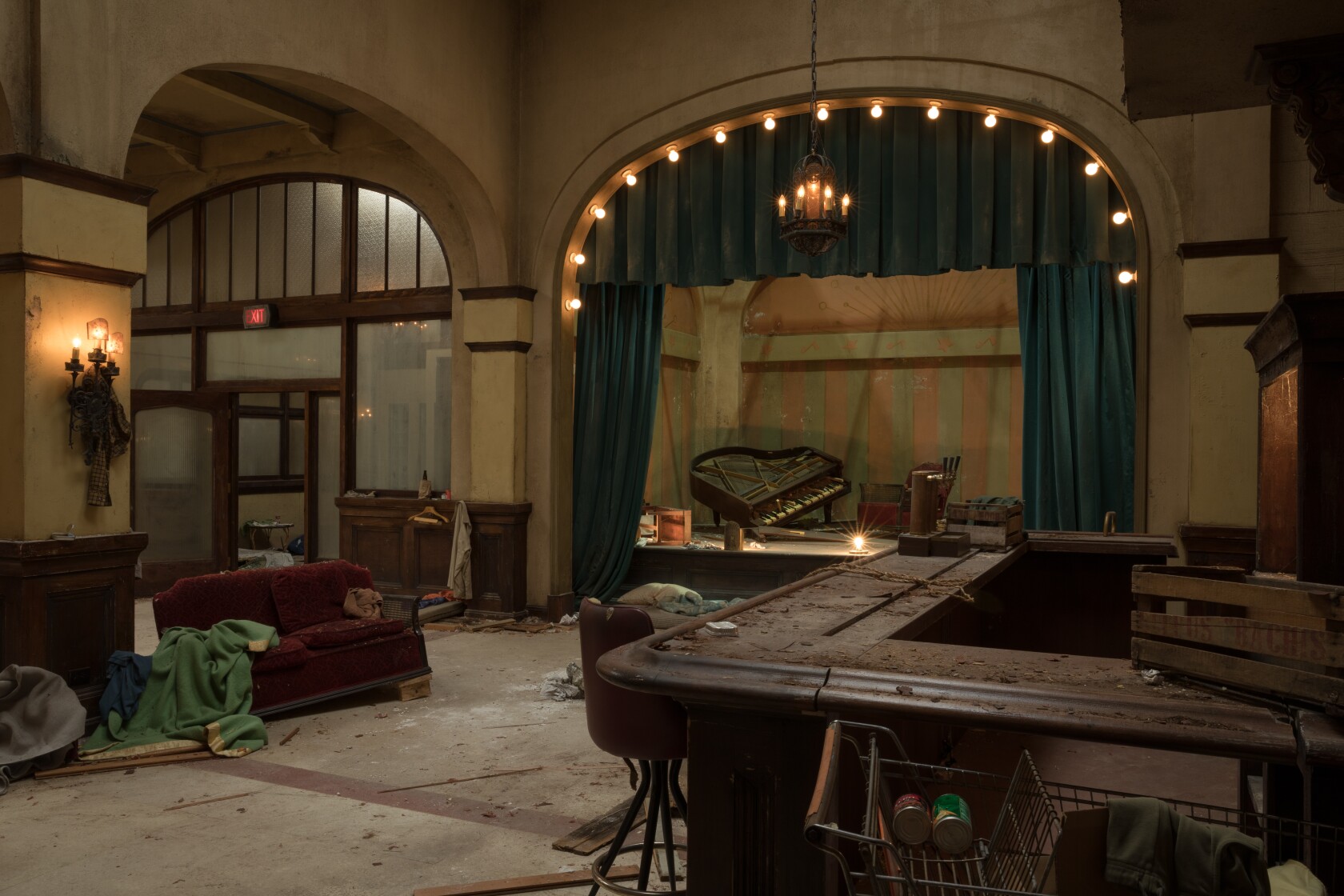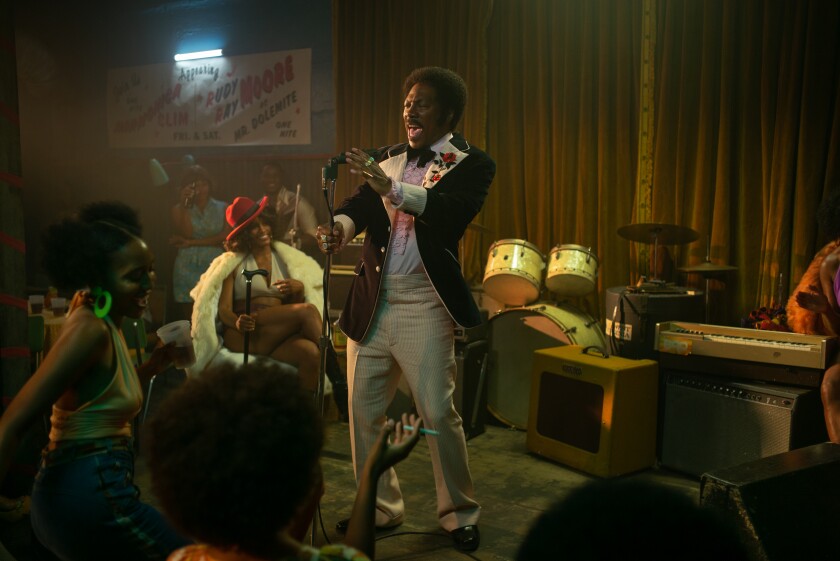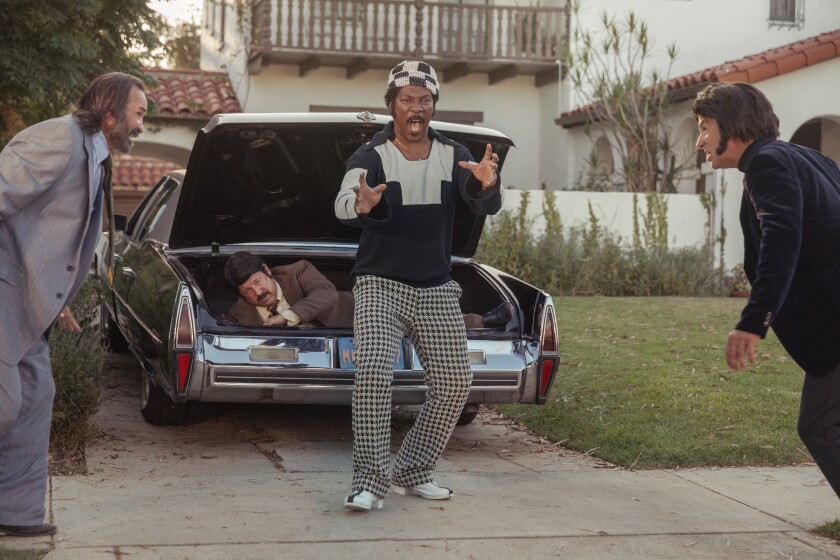by Sonaiya Kelley, Los Angeles Times
For location manager David Lyons, working on Netflix’s Eddie Murphy comedy “Dolemite Is My Name” was challenging but also exhilarating.
The self-proclaimed “die-hard Dolemite fan,” along with production designer Clay A. Griffith, had to juggle roughly 89 Los Angeles locations and 118 sets to accurately tell the story of Rudy Ray Moore, a record shop worker turned stand-up comic turned unlikely movie star. “I would be prepping a location, filming a location and striking another location all at the same time,” Lyons says. “The sheer volume was remarkable.”
In fact, Lyons (whom Griffith calls a “walking encyclopedia” of “Dolemite” knowledge) already knew where many of the scenes for the original “Dolemite” were filmed before getting attached to the project. “As a location scout, it’s what I used to do in my free time,” he says. “Figure out where they shot the movies I liked. My best friend and I discovered it when we were 14 years old, which is the perfect age to discover foul-mouthed comedy. Thirty years later I could still utter a line from ‘Dolemite’ and he knows exactly what I’m talking about.”
The Times caught up with Lyons and Griffith for a tour through eight of the L.A. locations featured in the film and what it took to restore them to their 1970s glory.

Royal Lake Apartments
1109 S. Lake St. Rudy Ray Moore set up shop at the then-dilapidated Dunbar Hotel — once considered "the finest black hotel in the nation" as the Los Angeles Conservancy describes it — and transformed it into a makeshift movie studio as well as his living quarters. Now refurbished, the Central Avenue building serves as a retirement home, which complicated the Murphy team’s shooting plans.
“We realized it was not going to be feasible to have a shooting crew come in and shoot for 14 days,” says Griffith. “We would have to dislodge everybody in the building and it just wouldn’t work.”
Instead, the Royal Lake Apartments in L.A.'s Pico-Union neighborhood, stood in for the exterior of the hotel, largely because it shares the same arched windows as the Dunbar. (Interiors were shot at Los Angeles Center Studios.)
“The building itself is mostly vacant and just beautiful,” Lyons says. “It’s from around the same era as the Dunbar, but more importantly from a logistics standpoint we were able to film it.”
Historic archives were used to reproduce the original signs and in the end, the new location looked more convincing than the original.
“The Dunbar has maybe 60% of what looks like 1974 and the rest of it looks like 2019,” Lyons says. “With the Royal Lake, you could stand there and look 360 degrees and it feels like you’re in 1974 Los Angeles.”
One production hiccup came after a gas leak forced the crew to evacuate the building. “We had to hold production while the city trucks came out and dug a hole in the street,” Lyons says. “We also had a problem with the Los Angeles Fire Department because the building had been red-tagged, but luckily we were able to work that out and it didn’t affect filming.”
Toyon Canyon, Griffith Park
In Moore’s original film, police car chase scenes were shot at L.A.'s Bronson Caves, but the popular tourist destination inside Griffith Park posed too many logistical challenges to be used.
“When Rudy Ray Moore and his team went there and shot it in 1975, they just went up there without a permit,” Lyons says. “They blew up a car, didn’t tell anybody about it and probably just left it there. We don’t do things that way anymore.”
Plus, the ground by the caves had shifted significantly in the interim years due to erosion — which made Bronson Canyon nearly impossible to drive a car through anymore. “I don’t think we could safely control it without putting others at risk who were having picnics and whatnot,” Lyons says. “So we picked a more desolate area called Toyon Canyon and basically just made it look like it did in 1974.” Until 1985, the area was used as a landfill. In 2013, after a multimillion-dollar restoration, the canyon was reopened to the public.
“We chose a remote area on the backside of the park, sort of on the Valley side,” Griffith says, “because it was much more accessible for the crew to use without interfering with people hiking and stuff like that. We didn’t want to spend a lot of time doing crowd control.”
One production hiccup came when a fire broke out close to the Griffith Park Observatory and the entire area had to be evacuated. “We constantly had these weird things happening while shooting around Los Angeles,” Griffith says. “And then we had that heat wave last July where it was like 107 degrees. It was challenging but we got through it all.”
Fortunately for the art department, very little had to be done to restore Griffith Park to its 1970s glory. “The beautiful thing about the park is it kind of looks the same as it did way back when,” says Lyons. “It still can play itself.”
Poo-Bah Record Shop
2636 E. Colorado Blvd., Pasadena. Poo-Bah stood in for the now-closed Dolphin's of Hollywood Record Shop, the store on Vernon and Central Avenue where Rudy Ray Moore finds himself at the start of the film.
“We actually looked for record stores that were still selling vinyl LPs because we had to re-create literally every album cover,” Griffith says. “Getting clearance for the artwork would take months and months and so many people own the rights. So we re-created it all and put our records in front of their records so that it looked like we had a lot more records than we really did.”
Shooting coincided with Quentin Tarantino’s production of the 1969-set “Once Upon a Time ... in Hollywood,” which led to some competition between the rival production teams.
“The two art departments were sort of fighting over period props in the prop houses, like who could get there first,” Griffith says with a laugh.
To match the look of Dolphin’s of Hollywood, Poo-Bah required a complete location redesign. “We basically stripped everything off their walls and rebuilt it to period style from research,” Griffith says. “We repainted the whole place, put up our posters and built older aged-looking record bins.”
While making the graphics from scratch, Griffith was careful not to make everything too ’70s-specific.
“My theory is that when something’s from the ’70s you should actually design stuff that was made in the late ’50s,” he says. “We didn’t want to put too fine a point on it being 1975. Real life wasn’t really like that so we looked at research that was from 1965 to 1968 and did our graphics and artwork in that respect.”
“What’s really fun about Poo-Bah is they were so impressed with the work that Clay did that they left a lot of the decoration in there,” says Lyons. “If you go in there now it looks more like Dolphin Records than like Poo-Bah when I originally found it.”
The original Dolphin’s of Hollywood is now a beauty salon.
El Cid and Los Globos
4212 Sunset Blvd. and 3040 Sunset Blvd. Moore originally performed at the Californian Club on Santa Barbara Avenue (now Martin Luther King Boulevard) and later shot “Dolemite” there. It’s now a laundromat. Moore also filmed “Dolemite” and its sequel, “The Human Tornado,” at the Total Experience nightclub on Crenshaw Boulevard. It was demolished to build a Lowe’s home improvement store. Instead, the club El Cid served as the interior of the Californian Club while Los Globos stood in for a few Chitlin Circuit venues seen in the movie.
“We looked at 30 or 40 different locations before we landed on El Cid,” Lyons says. “Basically what El Cid provided us with was the intimate vibe of the original Californian Club, but also ceilings that were high enough to light.”
“El Cid just had such a wonderful feel on the inside,” Griffith says. “It could’ve been timeless because it was so dark and with the red drapes it just had a great nightclub feel.”
Los Globos worked as multiple Chitlin Circuit venues because its layout is different from the other clubs seen during Moore’s time on the road.
“Los Globos had the look of a 1970s Anytown, U.S.A. club,” Lyons says. “The tile floor and the red leather on the walls helped us sell the time-appropriate design.”
“As far as design goes, doing the Chitlin Circuit was my favorite part of the movie,” says Griffith. “I went to school in Tennessee and was familiar with these blues joints that were just small little places on the side of the road. The unique detail and character of them was fun to put a fingerprint on. I fall in love with it every time I see it.”
Orpheum Theatre
842 S. Broadway, Los Angeles. Though “Dolemite Is My Name” implies that the distributor-backed world premiere of the original film was held at the Orpheum Theatre in downtown Los Angeles (after an independent screening at Indianapolis’ Uptown Theatre and several pay-to-play “four wall” showings), “Dolemite’s” official premiere was held at Chicago's Woods Theatre, which has since been torn down. The Orpheum became the premiere venue and served as a full-circle moment in the story.
“The place where he decides that he wants to be up on the screen and make a movie is the place where he ended up having the premiere,” Griffith says. “So it really works for the story line.”
Another reason the filmmakers settled on the Orpheum was because it was built in the same time period and done in the same ornate style as the Woods Theatre.
“These elaborate movie palaces of the 1920s and 1930s while the Depression was going on were being built to help people escape their everyday tragic existences,” Lyons says. “The actual feeling that you get when you walk in, I mean, they call them movie palaces for a reason.”

The Rendon Hotel
2055 E. 7th St., Los Angeles. The Rendon Hotel was used for four different sets: two Chitlin Club interiors, the exterior of Rudy’s apartment and a Chitlin Club exterior. The inside of Rudy’s apartment was actually shot in the Barclay Hotel on 4th and 9th.
“We really liked the urban feel of that whole corridor so it really worked out well for us,” Griffith says. “It’s sort of like a montage of sets in a way. We also used it for when he goes back on the road to Chicago. On the ground floor we put in three different areas that we were using for Chitlin Clubs and then outside was the exterior of the prostitution house where he was selling his records.”
“Every time you moved the camera it looked like you were looking at a different spot,” Lyons says. “It’s one of those places that’s just trapped in amber. Something frozen in time and it’s just that beautiful old Los Angeles architecture.”
5143 Sunset Blvd.
The now-defunct Dimension Pictures, which distributed “Dolemite,” at one point was located at 9000 Sunset Blvd. in West Hollywood. For “Dolemite Is My Name,” Dimension was replicated further east in a building that came already outfitted with period-specific furniture and decorations.
“Dimension was one of those companies that kept moving around so we could never find any historical records on it at all,” Griffith says.
One of Lyons’ scouts alerted him to the building. “He was showing me pictures and I thought he was messing with me,” says Lyons. “I said, ‘Seriously, these are vintage photos right? And he’s like, ‘No, that’s how the place looks!’”
“It looked like nothing had changed inside that building since 1965,” Griffith says. “From the furniture to the colors on the walls to the dressing, I was drop-jawed when we walked in.”
The crew replaced the artwork on the walls with custom period film posters of movies distributed by the studio. “We probably did about a dozen of those and changed all the drapes and brought all that sort of stuff into the correct period,” Griffith says.
“It may be my favorite location from the entire movie,” Lyons says. “It’s just so beautiful. It was just a glorious gem of a location that we were lucky enough to stumble upon.”

1949 Buckingham Road
This location is the only one in the film that was also used in Moore’s original “Dolemite” film.
“That was a major coup for me because I found all of the original locations from the movies, but many of them we just weren’t allowed to film for various reasons,” Lyons says. “We began to refer to it as sacred ground. In 1974, Rudy probably went up to that house, didn’t even knock on the door, filmed the scene and moved on down the street.”
Lyons managed to determine the house’s location by rewatching the scene repeatedly, first on VHS and then on Blu-ray, trying to make out the address a few blocks west of Crenshaw Boulevard.
“I got so excited the day I found it on Google Earth and it was like 2 a.m. and I woke my wife up to show her the location. She wasn’t nearly as excited about it as I was.”